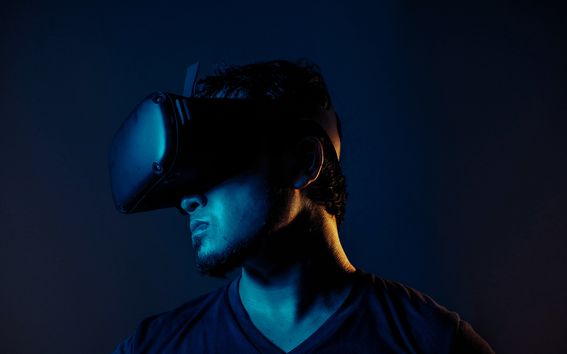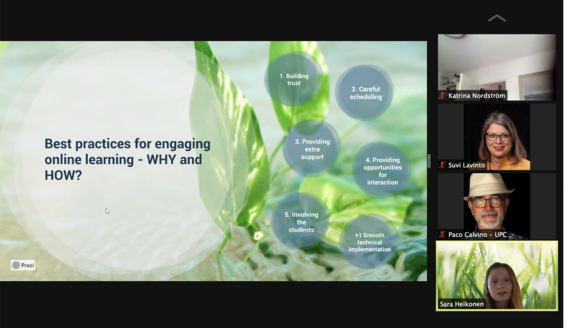Unite! virtual campus ideated further at the Boot Camp

Unite! Boot Camp gathered together 140 teachers and staff from the seven Unite! partner universities to discuss the developments of Unite! teaching and learning activities. During the Boot Camp Aalto University facilitated a design sprint on virtual campus consisting of three sessions. The aim was to gather the whole range of issues and ideas on virtual learning and virtual reality to facilitate building of a virtual campus within Unite!.
“The design sprint at the bootcamp was a success. We followed a T-shaped structure, first generating ideas at a wide range, and created understanding on bottlenecks about virtual learning. In the second part we chose to take a deep dive on virtual reality and design how it can be further used in teaching and learning. At the final third part called ‘decide’ we first learnt about best practices on online learning as presented by Sara Heikonen. We continued with Fatma Souissi, the student representative from SURE! of Unite!, who timely shared students' wishes and requirements about the virtual campus, and also learnt about three practical cases on using virtual reality. To finalise the design sprint we ran breakout groups to identify which approaches, practices and development projects we decide to utilise. We will next operationalize all these results to action within Unite! and beyond.“, says Tomi Kauppinen, the task force coordinator of Unite! Virtual Campus, and Head of Aalto Online Learning.
Laura SivulaVirtual learning is the new normal.
The first part of the design sprint aimed to share and understand both bottlenecks and opportunities about virtual learning. Via brainstorming the groups generated as many ideas as possible, and came up with solutions what would be suitable for implementation in each partner university.
“Virtual learning is the new normal. During the past year, we have had to adapt to new pedagogies and new technologies, but now it’s time to think what comes after the pandemic, what will be the new normal in a post-Covid world”, stated Laura Sivula, Head of Summer Schools at Aalto University, who facilitated the first sprint with her colleagues Laura Kitinoja and Regina Castelejn-Osorno.
Laura Sivula introduced factors to take into account when designing good teaching practices:
- Mobile learning: When planning for virtual learning platforms we need to consider how to engage students on the devices and platforms they already use? Generation Z has a mobile-first mindset, they socialize, connect and consume media in vastly different ways then previous generations. Mobile learning happens across multiple contexts, through social and content interactions, using personal electronic devices.
- Microlearning: How can we engage students in continuous learning? Microlearning is a holistic approach for skill-based learning and education, which deals with relatively small learning units. It involves short-term-focused strategies especially designed for skill based understanding/learning/education.
- Personalized learning experiences: How can we best personalize learning experiences for students? Personalized learning experiences can be provided with a mixture of technologies and pedagogies. There is a shift from teacher-centered to creating a student-centered and optimally, a student-driven class room, where students have choices in the pace, tools, learning objectives and their interests.
- Peer learning: How can we build student communities of online learners? Sivula thinks this is a real opportunity for Unite!. Peer learning is an effective way to make learning interesting and teach students to develop an array of useful skills such as communications, teamwork, leadership, delegation and the ability to give and receive feedback.
Virtual reality in teaching
The second part of the design sprint on using virtual reality in teaching was run by Julia Sand, a master student from Aalto University School of Arts. According to Sand people learn better when learning happens in an authentic environment and when the learner has an active role. Learning in more authentic contexts has been found to improve motivation and understanding. Providing the context helps the learner to make conceptual connections between the individual learned facts. Authentic environment helps memorization. For this kind of situated learning simulations in virtual environments can be used. Students tend to find active participation in simulations to be more interesting and intrinsically motivating. Simulations also enable the learning contexts that would normally be impossible, expensive or dangerous.
What can VR offer specifically that other mediums can’t? Virtual reality is a highly immersive media offering the feeling of being part of the digital experience. For the learner it helps with concentration and engagement – it closes off the surroundings and only shows what’s relevant. VR also allows for bodily interactions. When you move, more neural pathways are activated resulting in a stronger memory trace. In VR learning environments the natural interaction with 3D digital objects seems to be connected to a better memorization, engagement and concentration. VR can be used in situated learning approaches and to give context to the subject matter to be learned or to take the learner to an environment that would be impossible to experience in real life. The freedom to explore the digital environment may contribute to the feeling of control that is connected to intrinsic motivation.
Davide Calandra, Gabriele Prattico and Federico De Lorenzis from Politecnico di Torino, introduced three practical examples on how virtual reality can be used in teaching of physics, in the training of firefighters and on conducting energy audits.

What do students wish from the Unite! virtual campus?
Fatma Souissi, the student representative from SURE (Students in Unite! for Representation and Empowerment) of Unite!, presented what students wish from the virtual campus. The platform should be user-friendly and accessible on web and mobile. It should have a space for interaction outside of the course times, e.g. a virtual coffee break or lunch just like on a physical campus. Communication channels should allow constant communication between students and teaching staff. Avatar-based tools should be considered to compensate the missing physical social interactions. Live lectures should be available afterwards as recordings and if other resources are necessary then they should be open source or the students should be provided a free campus licence. “It’s essential also to promote the importance of mental health and a healthy work/life balance, to encourage creativity and individuality as well as to recognize students with difficulties and offer them assistance,” concludes Soussi.
Sara Heikonen, master student and course assistant at the School of Engineering, shared best practices for online learning based on experiences from the Master’s Programme in Water and Environmental Engineering at Aalto University. Careful scheduling, ensuring smooth technical implementation, providing extra support for students and opportunities for interaction as well as involving the students through e.g. polls and group discussions are some of the crucial elements for building engaging online learning experiences.
What is Unite!?
Unite! is one of the European University Alliances funded by the European Commission. Aalto University is a member of Unite! alliance together with 6 other high-level European technical universities.
Unite! will set a new model for a European virtual and physical inter-university campus. Unite! will connect engineering, science and technology with the grand challenges of society in co-creation by students, faculty and staff – providing skills for a new generation of European and global citizens.
Get to know Unite! (aalto.fi)
- Published:
- Updated:
Read more news

DeployAI Partners Gather for Heart Beat Meeting in Helsinki
The European DeployAI project's partners gathered for the Heart Beat meeting hosted by Aalto University Executive Education in Helsinki.
HRH Princess Maha Chakri Sirindhorn of Thailand visited Aalto University
During the visit, HRH and her delegation met with Aalto students and explored various activities.
Online AI course could boost study equality
Students at the School of Business believe that mastering Artificial Intelligence (AI) can be beneficial for both academic success and career prospects, as AI becomes increasingly integrated into daily life.